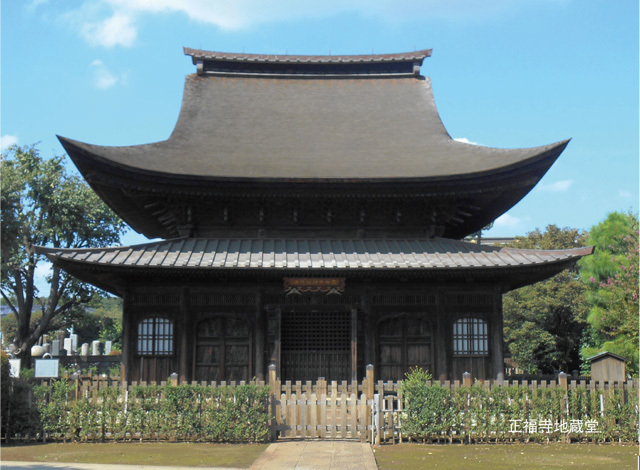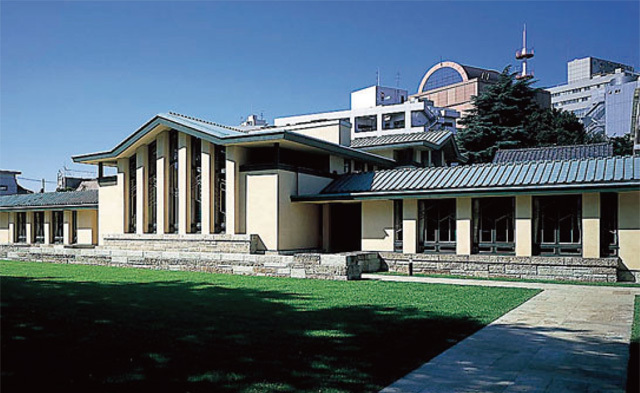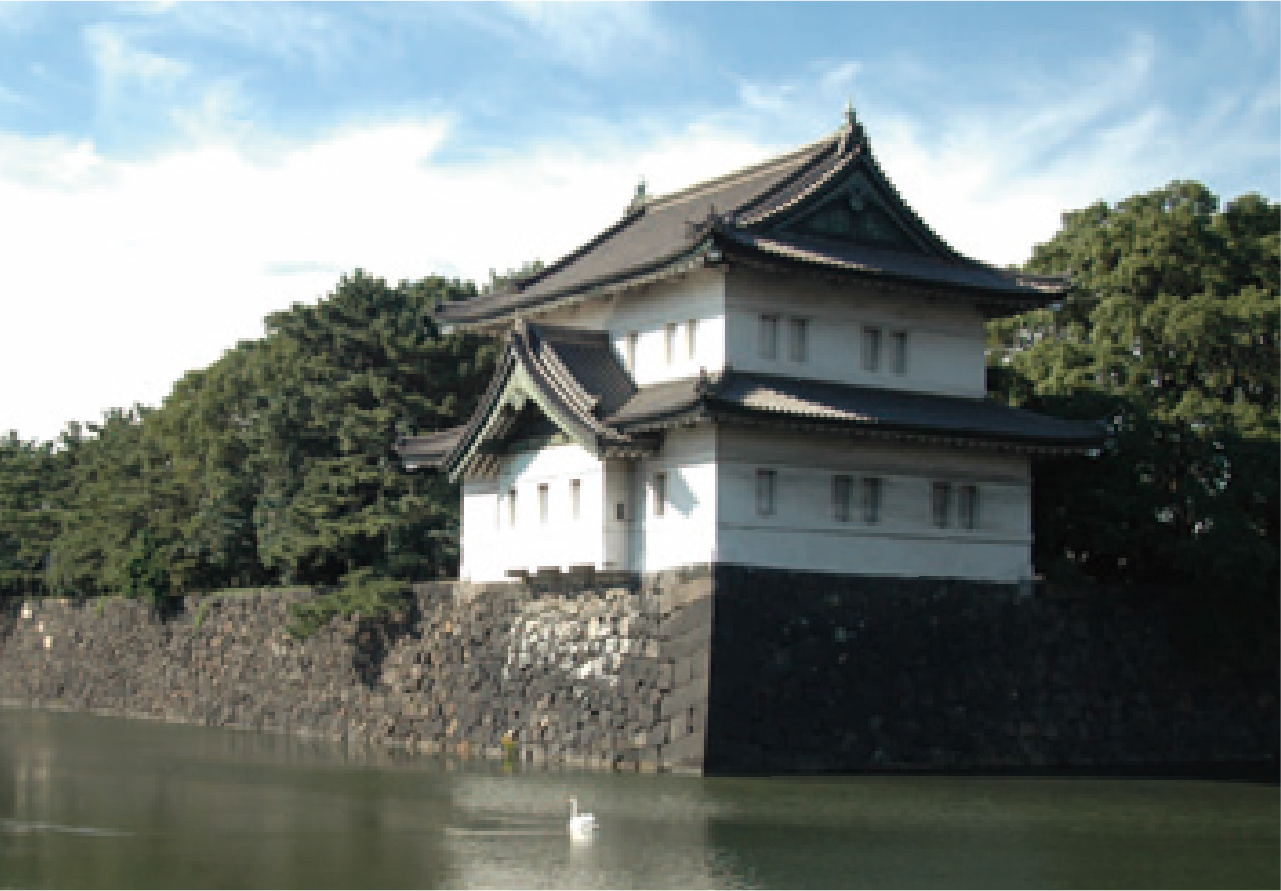
Let's take a stroll about the former Edo Castle
Chiyoda city Course
The current Imperial Palace is located on the former site of Edo Castle (Chiyoda Castle) surrounded with a large forest in the center of Tokyo. Edo Castle was developed as the political center of the TOKUGAWA administration as well as the home of the line of TOKUGAWA shoguns. Edo Castle covered a vast area which was encircled by Yotsuya to the west, Asakusa to the east, Suidobashi to the north, and Toranomon to the south.
This autumn, among the sites open to the public in the spacious Edo Castle, the highlights such as Ninomaru and Nishinomaru currently located in the East Gardens of the Imperial Palace and its Outer Gardens and so on, were selected for a walking course during the Tokyo Heritage Week. Let's take a stroll about the former Edo Castle, an oasis in downtown Tokyo.
Walking Course
Edo Castle was originally built by OTA Dokan, an influential vassal, in 1457. After a succession of owners, TOKUGAWA Ieyasu made it his residence mainly because TOYOTOMI Hideyoshi had offered him the former territories of HOJO Clan's of Odawara.
The construction of Edo Castle continued through three generations of TOKUGAWA rulers (Ieyasu, Hidetada and Iemitsu), and a whole of Edo Castle was almost completed in 1636.
Edo Castle was a huge complex built up with various Kuruwa (citadels) such as Main Palace consisting of Honmaru, Ninomaru and San-nomaru, Saijo (West Palace) consisting of Nishinomaru and Momijiyama, and a spacious strolling garden called Fukiage, besides Kitanomaru and Nishinomarushita.
These Kuruwa (citadels) were divided by numerous inner moats, and the inner compound of the castle was encircled by outer moats of the entire perimeter of about 14 kilometers.
In and around the current Imperial Palace, a lot of cultural heritage sites taken over from Edo Castle still remain to this day, such as moats, stone walls, gates and yagura (turrets) which were designated as National Special Historic Site (Edo Castle Remains), and Tayasu-mon Gate, Shimizu-mon Gate and Outer Sakurada-mon Gate were designated as National Important Cultural Properties (Buildings). In addition, as the remains inheriting Edo Castle's historic sites, Remains of Edo Castle Outer Moats and Site of Tokiwabashi-mon Gate located between Ushigome and Akasaka were designated as National Historic Site.
Walking Course Highlights
- Ote-mon Gate
- Otesan-no-mon Gate
- Nakano-mon Gate
- Chujaku-mon Gate
- Honmaru
- Tenshudai (Donjon Base)
- Stone Walls around Hakuchobori Moat and Shiomizaka Slope
- Ninomaru Garden
- Sakurada-niju-yagura
- Nijubashi Bridge
- Outer Sakurada-mon Gate
Route Map
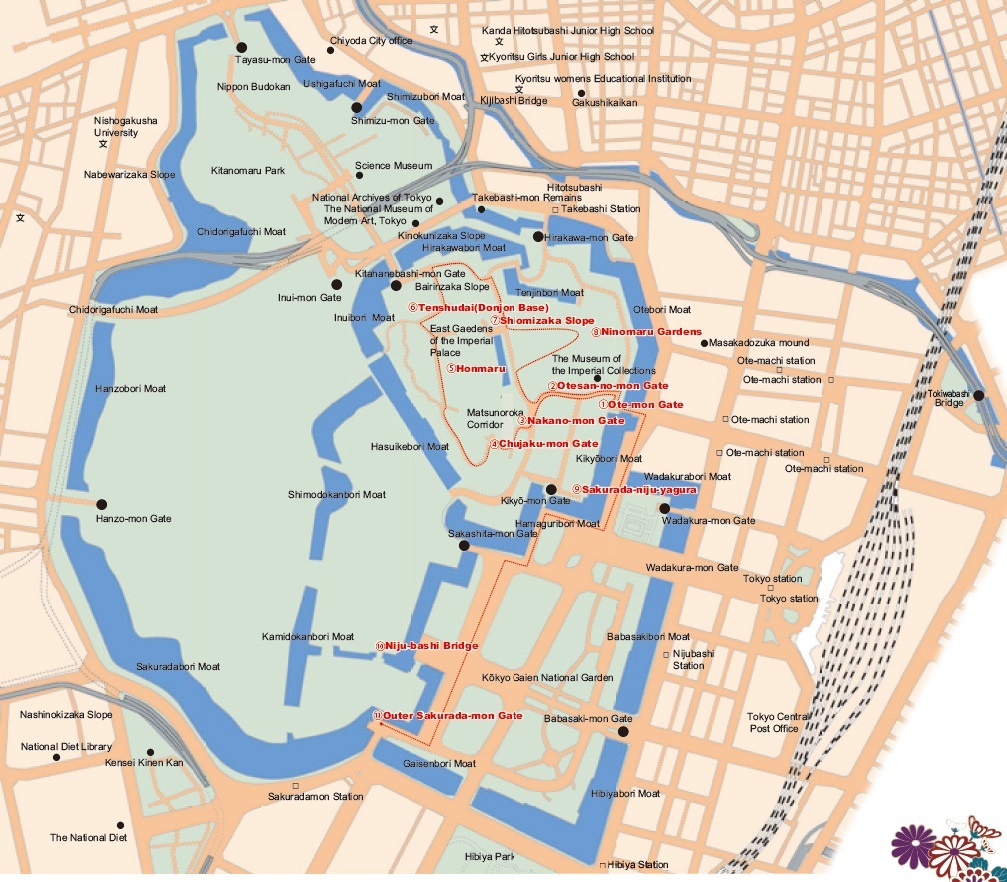

Reference
Brochure (PDF)
(The Route for Feudal lords)
Chiyoda city Course
1
From Ote-mon Gate to Chujaku-mon Gate
(The Route for Feudal lords)
Ote-mon Gate was one of the front gates of the former Edo Castle. Feudal lords had to enter the castle from this gate or from the Inner Sakurada-mon Gate (Kikyo-mon Gate). Feudal lords were usually required to reduce the number of their attendants before entering the inner castle compound, so most members were forced to wait the outside of the current Imperial Palace area. Especially at the time of a New Year's period when many Feudal lords visited the shogun to offer their greetings, it is said that this area became bustling with many merchants coming over to do business with the waiting members.
① Ote-mon Gate
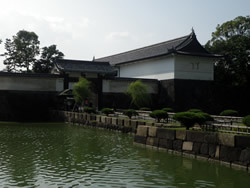
Current Ote-mon Gate
Ote-mon Gate of Edo Castle was a "Masugata" gateway. That is, for defense, the gateway was surrounded square with stone walls, and was constructed not to be able to go straight. Inside the gate, there soared a solemn structure of Watariyagura-mon Gate which had a turret for an arsenal. As Ote-mon Gate was the main entrance for feudal lords, going through the two gates, from Korai-mon Gate to Watari-yagura-mon Gate at the inner-right side. The two of the "Fudai" feudal lords (vassal before the TOKUGAWA Shogunate) stipend more than 100,000 koku, were assigned by turns to take in charge of keeping guard day and night, armed with guns, etc. Ote-mon Gate was burned down by the Great Fire of Meireki, and was reconstructed in 1659.
Other portion of Ote-mon Gate, except for Korai-mon Gate, was burned down by the Great Kanto Earthquake and the World War II air-raids, etc. and was reconstructed in 1966 at the time the East Gardens of the Imperial Palace was opened to the public.
Only Korai-mon Gate has still remained through all these disasters since 1659, showing the original presence of the Edo period.
Inside the Korai-mon Gate, there is an ornament of "shachi" (dolphin) which used to be on the roof of the original Watari-yakugura-mon Gate.
② Otesan-no-mon Gate
This gate is also called Gejo-mon Gate (dismount gate). Originally, in front of this gate, there was a moat dividing San-nomaru from Ninomaru.
The building on the right side in this old photograph is a Doshin Bansho (guard house) which was transferred to inside of the gate.
In the Edo period, the feudal lords except for the three branch families of the TOKUGAWA Clan, had to dismount from their horses or palanquins at this gate, so there were signs written with the words "Dismount/Get off". It is said that many vassals, while waiting here, exchanged various information with their counterparts from other families.
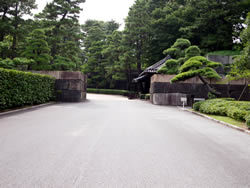
Current Otesan-no-mon Gate
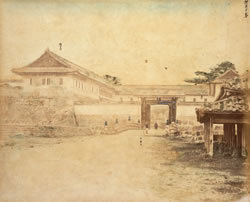
Otesan-no-mon Gate,1871
'Honmaru Gejo-mon Zu' National Important Cultural Property "Photograph Album of the Former Edo Castle"
③ Nakano-mon Gate
Otesan-no-mon Gate and Nakano-mon Gate were the front gates leading to Honmaru, therefore, together with Chujaku-mon Gate, made one pivotal gate, performing an important role to protect Honmaru, linked up with Hyakunin Bansho (one hundred guard house) and O-Bansho (superior guard house).
In the Watari-yagura stood on the stone walls, O-yumimochi o-mochizutsu kashira Yoriki Doshin (head of shooting and firearms troop) stood guard for the shogun.
Yoriki and Doshin were TOKUGAWA government officials who worked for general affairs and police.
Shoin-Banto (head clerks) were also stationed in O-Bansho located at the inner-right side of the gate.
The stone of walls in this area, were big enough to overwhelm feudal lords.
According to the excavation conducted by the Imperial Household Agency and Chiyoda City Board of Education, the reconstruction after the Great Fire of Meireki (1657) was conducted by HOSOKAWA Family of Kumamoto Domain, and the stones are transported all the way from Setonaikai and Kii Peninsula, and was again reconstructed after the Great Earthquake in 1703 by IKEDA Family of Tottori Domain.
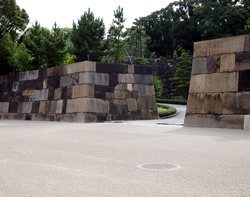
Current Nakano-mon Gate
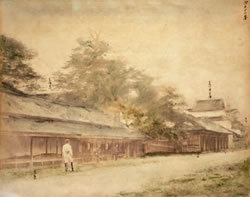
Hyakunin-bansho, 1871 'Honmaru Terasawa Niju-yagura Zu'
National Important Cultural Property "Photograph Album of the Former Edo Castle"
④ Chujaku-mon Gate
This gate is also called Goshoin-mon Gate leading to the front entrance of Honmaru Goten.
As the old photograph shows, the gate surrounded by Niju-yagura and Tamon-yagura buildings, was once strictly guarded to protect the shogun, but in 1863, the gate was burned down by catching fire from the Honmaru Goten.
Today, only a site of stone walls remains the dreadful mark of fire with scorched stones.
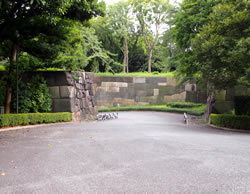
Current Chujaku-mon Gate (Only stone wall remain today)
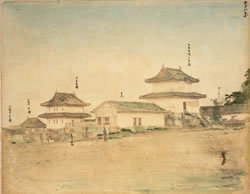
Chujaku-mon, 1871 'Honmaru shoin Niju-yagura oyobi jubako-yagura Zu'
National Important Cultural Property "Photograph Album of the Former Edo Castle"
Opening times of the East Gardens of the Imperial Palace
- Open :
- From March 1 to April 14 / 9:00 a.m. - 4:30 p.m. (entry up to 4:00 p.m.)
From April 15 to the end of August / 9:00 a.m. - 5:00 p.m. (entry up to 4:30 p.m.)
From September 1 to the end of October / 9:00 a.m. - 4:30 p.m. (entry up to 4:00 p.m.)
From November 1 to the end of February / 9:00 a.m. - 4:00 p.m. (entry up to 3:30 p.m.)
- Closed :
- The Garden is closed on the following days and occasions.
Every Monday and Friday (open on National Holiday except the Emperor's Birthday, December 23)
In the event that a National Holiday falls on a Monday, the Garden will be closed on the Tuesday immediately following the National Holiday.
From December 28 to January 3
In circumstances where it is deemed necessary to close the Garden due to Imperial Court functions or other occasions.
- Entrance and exit gates :
- (Free of charge)
Ote-mon Gate, Hirakawa-mon Gate and Kitahanebashi-mon Gate.
∗ All of old photograghs are possessed by Tokyo National Museum.
∗ These photographs in the East Gardens of the Imperial Palace were taken with permission of the Imperial Household Ageney.
Chiyoda city Course
2 Honmaru of Edo Castle
⑤ Honmaru
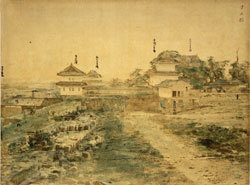
Honmaru Ruins,1871 'Honmaru-jubako-yagura, Shoinmonwatari-ato, Shoin-niju-yagura Zu'
National Important Cultural Property "Photograph Album of the Former Edo Castle"
This inner-most complex of Honmaru site, currently covered with an expanse of green lawn, was mostly occupied by Honmaru Goten with many Sumi-yagura (corner towers) and Tamon-yagura (hall turret) surrounded. Unfortunately, Honmaru Goten was burned down in the Fire in 1683, and was never reconstructed.
In the old photograph taken in 1871 shows the devastated state of Honmaru site.
Honmaru Goten had three main parts of buildings, from the south to the north, Omote, Oku (also called Nakaoku) and Ooku. Behind them was a main Tenshu (donjon). This area measures about 114,000 square meters. There was no specific boundary between Omote and Oku, but Nakaoku and Ooku were strictly separated, only connected by Osuzuroka Corridor.
The Omote (great outer palace) in the south side of the Honden, used for the politics and state of affairs, consisted of Ohiroma, Shiroshoin and Kuroshoin.
They were used for ceremonious rooms and reception rooms.
Ohiroma was counted as the largest and most ceremonious room in Edo Castle. The utmost solemn ceremonies such as the appointment of Seii Taishogun were observed here. Ohiroma had 4 level tiered floors with tatamimat, Jodan (the upper level floor), Chudan (the middle level floor), Gedan (the lowest level floor) and Irigawa (corridor space). It was strictly specified who sat where in Ohiroma, in accordance with attendee's political and social status. The Matsunoroka Corridor, famous for the Forty-seven Ronin incident (Chushingura) in 1701, combined Ohiroma and Shiroshoin, and it is said to have been the second longest corridor in Edo Castle with a total length of 60 meters.
The Nakaoku (middle interior) was the shogun's official residence, consisting of Gozanoma (shogun's office), Gokyusokunoma (rooms for state of affairs as well as shogun's spending daily life), and his private residence including kitchens and bathrooms.
Ooku (great interior) contained the private residences for the shogun, his wife, female servants, and so on.
According to the records written in the days under the fourteenth shogun Iemochi, a total of about 400 female servants lived here during the peak period. Comic books and movies set in Edo have often depicted historical female figures such as Princess GO, Kasugano Tsubone and Princess Atsu who resided in Ooku in the days of glory, to entertain today's Japanese audience.
⑥ Tenshudai(donjon base)
Tenshu (donjon) of Edo Castle was considered a symbol of the reigning shogun's power, so that it was reconstructed at each time of assumption of office.
Tenshu which was originally constructed by Ieyasu in 1606, was reconstructed by Hidetada in 1622 and by Iemitsu in 1638.
The first Tenshu built by Ieyasu, was the coalition formula castle tower to extend the southeast corner around Daitenshu (great tower), with the structure called Tenshu Kuruwa (tower citadel) including Niju-yagura and Sukiya-tamon.
It is estimated that the first Tenshu was located in the current Fujimi-tamon-yagura area. The Tenshu of the Kan'ei era was a five-story building of painted with black lacquer over 60 meters of the height, but was burned down by the Great Fire of Meireki in 1657.
The following year, MAEDA Family of Kaga Domain built Tenshudai (donjon base) with stone walls of 18 meters made of granite.
The rebuilding of the Tenshu was postponed, however, as priority was given to the reconstruction of the castle town, and was finally given up by the suggestion from HOSHINA Masayuki, an influential retainer of the shogun.
There was Kitahanebashi Bridge with Kitahanebashi-mon Gate, to the north of Tenshudai. Kitahanebashi Bridge was a buscule bridge for the defense of Honmaru. Two diagonal gutters against the Kitahane-iwakita-mon Gate on the photograph were for watersupply.
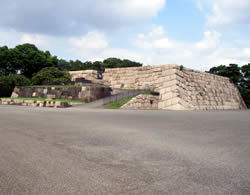
Current Tenshudai (donjon base)
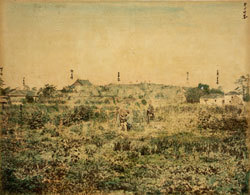
Tenshudai (donjon base), 1871 'Tenshudai Motookute Motogura Naimen Zu'
National Important Cultural Property "Photograph Album of the Former Edo Castle"
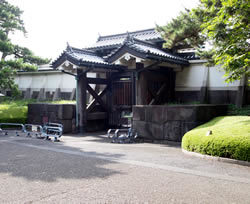
Current Kitahanebashi-mon Gate
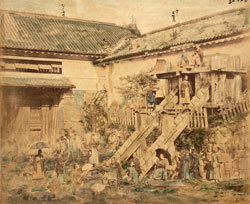
Kitahane-iwakita-mon Gate (right) and Kitahane-watarimon Gate (left), 1871 'Honmaru-kitahane-watarimon-nai-Suido zu'
National Important Cultural Property "Photograph Album of the Former Edo Castle"
⑦ Stone Walls around Hakuchobori Moat and Shiomizaka Slope
There was over 10 meters difference in level of Honmaru and Ninomaru and digged moats along the steps to protect Honmaru, with Bairinzaka Gate and Shiomizaka Gate built as well.
It is said that the sea could be seen well from this slope before Hibiya Inlet was reclaimed in the Edo period, so it was named Shiomizaka Slope.
Honmaru was originally encircled by the moats, but Hakuchobori Moat is the only moat which remains in the eastern side of Honmaru, and among the sites opened to the public, this area is also the only place where we see the stone walls constructed in the era of TOKUGAWA Ieyasu. This stone wall was built by the traditional methods, Ranzumi (masonry work with stones different in the size) and Uchikomihagi (implant grafting) method, and made each corner having a slight curve by using the traditional form of construction called Sangi-zumi (trimmed style piling) method.
As the stone walls located between Shiomizaka Slope and Bairinzaka Slope were built to enlarge Honmaru after the Great Fire of Meireki, it can be said that they are rather young as compared with other stone walls around the Honmaru area. This site of stone walls was built by Kirikomi-hagi method, piling stones very tightly without any gap between them, and Nunozumi method, piling square stones regularly. It will be enjoyable to compare the various methods of piling stones rather easily here!
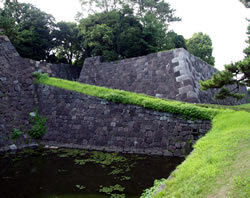
Current Shiomizaka Slope
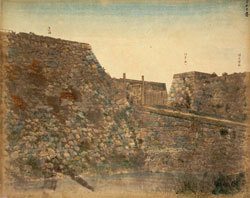
Shiomizaka Slope 1871 'Honmaru Shiomi-yagura Ato Zu'
National Important Cultural Property "Photograph Album of the Former Edo Castle"
Opening times of the East Gardens of the Imperial Palace
- Open :
- From March 1 to April 14 / 9:00 a.m. - 4:30 p.m. (entry up to 4:00 p.m.)
From April 15 to the end of August / 9:00 a.m. - 5:00 p.m. (entry up to 4:30 p.m.)
From September 1 to the end of October / 9:00 a.m. - 4:30 p.m. (entry up to 4:00 p.m.)
From November 1 to the end of February / 9:00 a.m. - 4:00 p.m. (entry up to 3:30 p.m.)
- Closed :
- The Garden is closed on the following days and occasions.
Every Monday and Friday (open on National Holiday except the Emperor's Birthday, December 23)
In the event that a National Holiday falls on a Monday, the Garden will be closed on the Tuesday immediately following the National Holiday.
From December 28 to January 3
In circumstances where it is deemed necessary to close the Garden due to Imperial Court functions or other occasions.
- Entrance and exit gates :
- (Free of charge)
Ote-mon Gate, Hirakawa-mon Gate and Kitahanebashi-mon Gate.
∗ All of old photograghs are possessed by Tokyo National Museum.
∗ These photographs in the East Gardens of the Imperial Palace were taken with permission of the Imperial Household Ageney.
Chiyoda city Course
3 Ninomaru and San-nomaru
⑧ Ninomaru Garden
Ninomaru and San-nomaru of Edo Castle served as the residences for the heir-apparent and the retired shogun. Ninomaru was completed in 1636 with a garden designed by KOBORI Enshu, the famed landscape architect of the 17th century, but Ninomaru was burned down in 1867, and left devastated for a long time.
In 1960, the cabinet decision authorized the project that a part of Honmaru, Ninomaru and San-nomaru of the former Edo Castle were renovated to the East Gardens of the Imperial Palace.
Ninomaru Garden was reconstructed to the strolling style garden based on the illustrated diagram planned under the ninth shogun TOKUGAWA Ieshige.
Today's visitors can enjoy viewing a wide variety of trees, plants and flowers throughout the year.
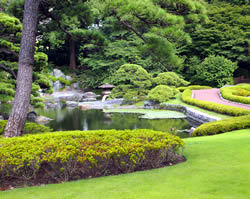
Current Ninomaru Garden
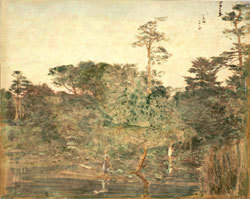
Ninomaru pond,1871 'Ninomaru Ike Zu'
National Important Cultural Property "Photograph Album of the Former Edo Castle"
⑨ Sakurada-niju-yagura
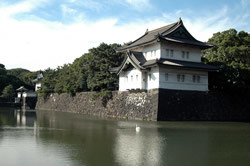
Current Sakurada-niju-yagura
This is also called Sakurada-tatsumi-yagura which was stored guns, bows, long spears, artillery and so on.
Originally, there were more than 20 yagura in Edo Castle, but only the three of them, Fujimi-yagura, Fushimi-yagura as well as Sakurada-niju-yagura, remain to this day.
Opening times of the East Gardens of the Imperial Palace
- Open :
- From March 1 to April 14 / 9:00 a.m. - 4:30 p.m. (entry up to 4:00 p.m.)
From April 15 to the end of August / 9:00 a.m. - 5:00 p.m. (entry up to 4:30 p.m.)
From September 1 to the end of October / 9:00 a.m. - 4:30 p.m. (entry up to 4:00 p.m.)
From November 1 to the end of February / 9:00 a.m. - 4:00 p.m. (entry up to 3:30 p.m.)
- Closed :
- The Garden is closed on the following days and occasions.
Every Monday and Friday (open on National Holiday except the Emperor's Birthday, December 23)
In the event that a National Holiday falls on a Monday, the Garden will be closed on the Tuesday immediately following the National Holiday.
From December 28 to January 3
In circumstances where it is deemed necessary to close the Garden due to Imperial Court functions or other occasions.
- Entrance and exit gates :
- (Free of charge)
Ote-mon Gate, Hirakawa-mon Gate and Kitahanebashi-mon Gate.
∗ All of old photograghs are possessed by Tokyo National Museum.
∗ These photographs in the East Gardens of the Imperial Palace were taken with permission of the Imperial Household Ageney.
Chiyoda city Course
4 Area around Inner Moats of Edo Castle
⑩ Nijubashi Bridge
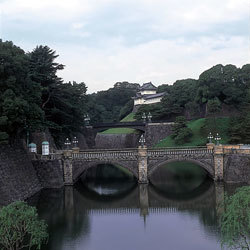
Current Nijubashi Bridge
One of the magnificent scenery in Tokyo is the Nijubashi Bridge from the Imperial Palace Outer Garden.
Nijubashi Bridge is often mistaken a stone bridge connecting the Imperial Palace and its Outer Gardens, but actually Nijubashi Bridge is the steel bridge located behind it.
This area is located in Nishinomaru of the former Edo Castle, and the stone bridge in the foreground is located at Nishinomaru Ote-mon Gate, while the steel bridge in the background is located at Nishinomaru Gejo-mon Gate.
It was once a wooden bridge with the double girders up and down to lead over the moat as deep as a ravine.
Since then, people began to call it Nijubashi (Double Bridge). Later on, however, the two separate bridges, the stone bridge and the steel bridge which appear as a single two story bridge, have been generally called Nijubashi. The current stone bridge was replaced from the wooden bridge in 1887, while the steel bridge behind it was replaced in 1888.
⑪ Outer Sakurada-mon Gate
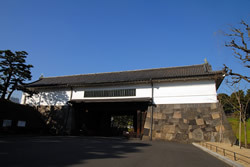
Current Outer Sakurada-mon Gate
This gate has been called Odawara-guchi Gate, which indicates that this gate led to the former Tokaido Highway, one of the major highways before Edo period. Because of it, this huge gate was counted as one of the key entrances for defending Edo Castle against its enemies.
This gate seems to have been originally constructed in the Kan'ei era (1624-44), and the current gate was built based on the gate reconstructed in 1663. Later on, it was once demolished, but was twice reconstructed, firstly in 1871, and secondly reconstructed after the Great Kanto Earthquake (1923).
In the Edo period, this was called as Outer Sakurada-mon Gate, and Kikyo-mon Gate was called as Inner Sakurada-mon Gate, both of them were on the route for feudal lords.
The location where II Naosuke, Tairo (chief minster) of the shogun and a feudal load of Omi Hikone Domain, was assassinated by a group of masterless samurai of the Mito Domain in 1860, just in front of current Metropolitan Police Headquarters. For this reason, the current Metropolitan Police Headquarters often goes by the name of "Sakurada-mon Gate" in today's TV dramas and movies.
Tayasu-mon Gate has the hinge inscribed "1636" and Shimizu-mon Gate has "1658", besides Outer Sakurada-mon Gate, still remain as the prototype for castle gates constructed in the early years of the Edo period.
Opening times of the East Gardens of the Imperial Palace
- Open :
- From March 1 to April 14 / 9:00 a.m. - 4:30 p.m. (entry up to 4:00 p.m.)
From April 15 to the end of August / 9:00 a.m. - 5:00 p.m. (entry up to 4:30 p.m.)
From September 1 to the end of October / 9:00 a.m. - 4:30 p.m. (entry up to 4:00 p.m.)
From November 1 to the end of February / 9:00 a.m. - 4:00 p.m. (entry up to 3:30 p.m.)
- Closed :
- The Garden is closed on the following days and occasions.
Every Monday and Friday (open on National Holiday except the Emperor's Birthday, December 23)
In the event that a National Holiday falls on a Monday, the Garden will be closed on the Tuesday immediately following the National Holiday.
From December 28 to January 3
In circumstances where it is deemed necessary to close the Garden due to Imperial Court functions or other occasions.
- Entrance and exit gates :
- (Free of charge)
Ote-mon Gate, Hirakawa-mon Gate and Kitahanebashi-mon Gate.
∗ All of old photograghs are possessed by Tokyo National Museum.
∗ These photographs in the East Gardens of the Imperial Palace were taken with permission of the Imperial Household Ageney.
Chiyoda city Course
Edo Castle Photographed --National Important Cultural Property "Photograph Album of the Former Edo Castle"--
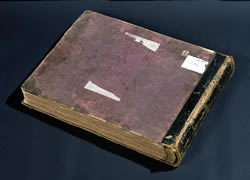
Photograph Album of the Former Edo Castle Tokyo National Museum
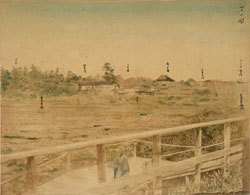
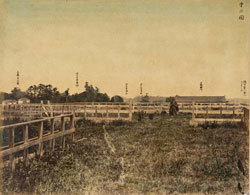
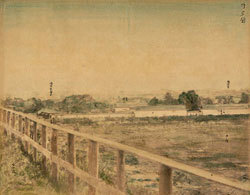
Edo Castle Honmaru Ruins
National Important Cultural Property "Photograph Album of the Former Edo Castle"
"Photograph Album of the Former Edo Castle", one of the collection for the Tokyo National Museum, is widely known as a collection of documentary photographs of the former Edo Castle in the early days of the Meiji period by promptly adopting a new visual source of modernization, photography, and was designated as National Important Cultural Property. These photographs were taken in March, Meiji 4 (1871). This album contains 64 photographs attached with two rough maps for both the inner and the outer citadels of Edo Castle, so viewers can easily find the location of each shooting point.
We cannot talk about this photo album without three persons. The first is NINAGAWA Noritane (1835-82) who initially planned to compile this shooting project. He was born to a family of workers for Toji Temple in Kyoto and had a keen interest in Japanese antique art from the early years of his life. After grown up, he was employed by the new Meiji government and became involved in founding today's Tokyo National Museum and also endeavored to promote the preservation of Japanese cultural properties. The second is YOKOYAMA Matsusaburo (1838-84), a photographer taking all the photos of this album. He grew up in Hakodate where the port was open to foreign ships for trade in the last years of the TOKUGAWA government. Living in Hakodate enabled him to be exposed to western painting and photography just brought in by diplomatic missions from overseas, and he was much impressed with the realistic depiction of subject matters in these western arts. Specifically, he wanted to study photography and traveled all the way to Shanghai at the end of the Edo period. After returning to Japan, he went to Yokohama to pursue further study of photography under SHIMOOKA Renjo. And the third whom we must not forget is TAKAHASHI Yuichi (1828-94). TAKAHASHI was born to a samurai family in Sano Domain of Shimotsuke Province. He was much interested in drawing pictures from childhood and entered the TOKUGAWA government's research institute for western painting. He pursued the Western skill of painting. The realism in oil paintings brought from the West fascinated him.
"Photograph Album of the Former Edo Castle" was compiled with 64 photographs taken by a Matsusaburo and thin coloring applied to all photographs by TAKAHASHI under NINAGAWA's direction. TAKAHASHI pursued the realism with water colors in this photo album. This album could not be compiled without anyone of them, NINAGAWA, YOKOYAMA, or TAKAHASHI.
Why did NINAGAWA document the photographs of Edo Castle in 1871? He wrote down his prospectus in the photo album as follows; "Now that Japan was unified by the new Meiji government after the Boshin War, the role of Edo Castle as a military center was over, and the maintenance, and repair for the castle will need not any more. Then, given the fact that these buildings are destined to be torn down, we record the state of Edo Castle by photography before being ruined." He continued further, "Although its military functions have been lost, this documentation would be useful for the future generations to review the Meiji period in Japanese history." He considered the castle as a missing relic due to civilization and enlightenment, and he regret them all very much. Therefore, he kept on being particular about it as possible exactly.
This photo album was compiled for viewers to understand the whole structure of the castle, even under the restriction of 64 pieces of photography. It begins with the site of Honmaru, and proceeds to inner complexes, the sites of Tenshu (donjon), Ninomaru, San-nomaru, Nishinomaru, Momijiyama, and many gates (Mitsuke) of both the inner and the outer citadels of Edo Castle. Among them, the photos taking Honmaru site outnumbered those of others, totaling 30 pieces of photos including the site of Tenshu. Also, these were taken by the devised method of shooting. Their camera was fixed on the Honmaru Daidokoro Sanju-yagura and the 360 degree circle view from Honmaru site were taken by changing angle.
But the state of Edo Castle at the time was devastated, only Nishinomaru (the site of the current Imperial Palace) remained at the inner side of the castle, as Honmaru and Ninomaru which were burned down in 1863 and 1867, besides Tenshu (donjon) which was lost by the Great Fire of Meireki, were never reconstructed.
Then, why did NINAGAWA record these sites without any buildings so obstinately? In this regard, there are various interpretations: "Honmaru site, though burned down, had been the hub of the TOKUGAWA administration which governed Japan over 260 years." Or "it was necessary to specify the end of the TOKUGAWA administration as this project was under the permission of the new Meiji government replacing the TOKUGAWA government," and so on. Any of these may not be far off the point, but when considering the former Edo Castle in Meiji 4 (1871), we should not forget that the castle was already the residence for the Meiji Emperor and that it was called Kokyo (Kojo at the time).
As the title for this photo album is "Photograph Album of the Former Edo Castle" we might regard it as a record of the castle for TOKUGAWA shoguns, but considering that the Meiji Emperor was a new owner of the castle instead of TOKUGAWA shoguns at the time, another interpretation could be added to this photo album.
Chiyoda city Course
Site of Tokiwabashi-mon Gate, located in the center of Edo Tokyo
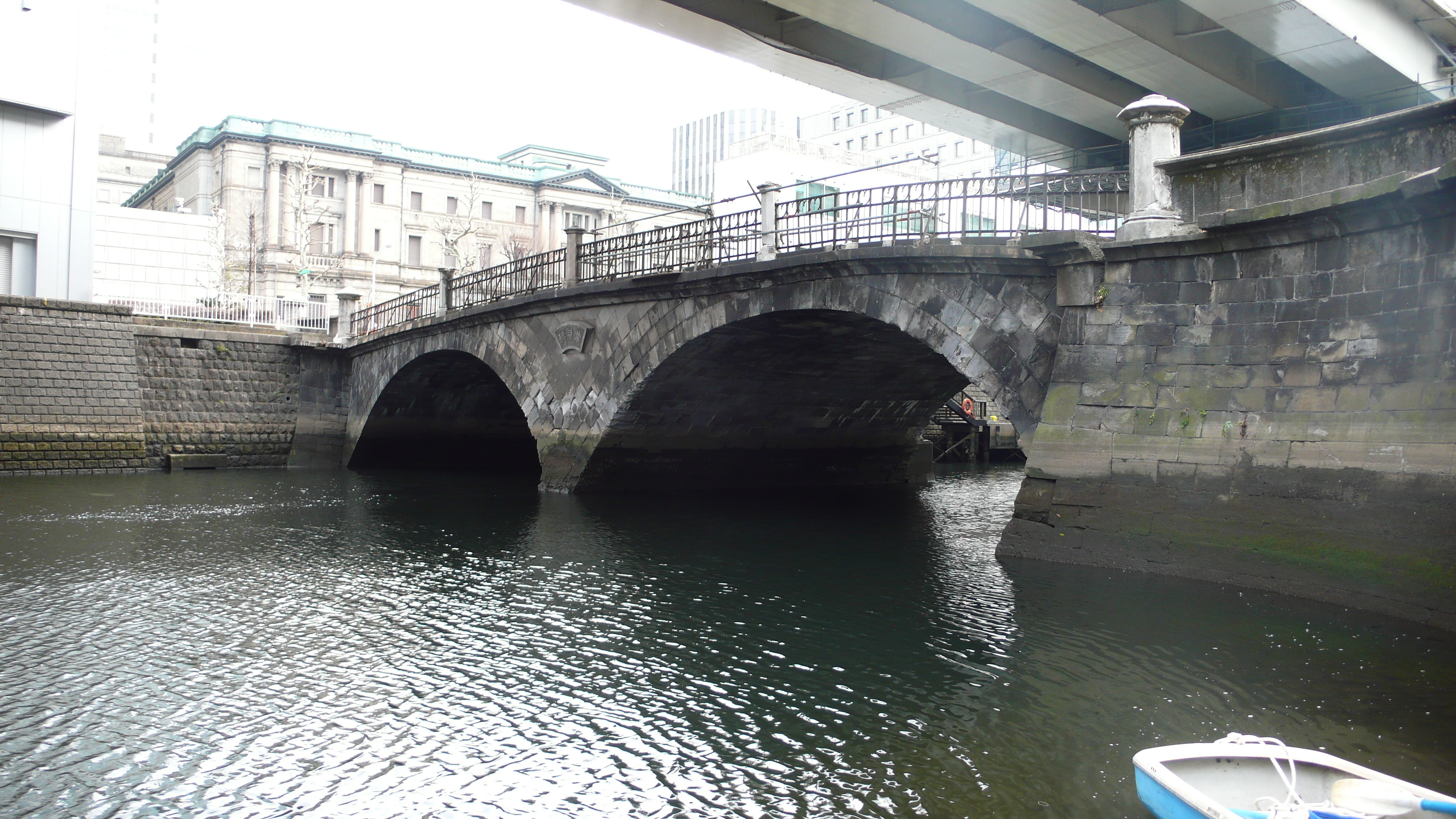
Current Tokiwabashi-mon Gate
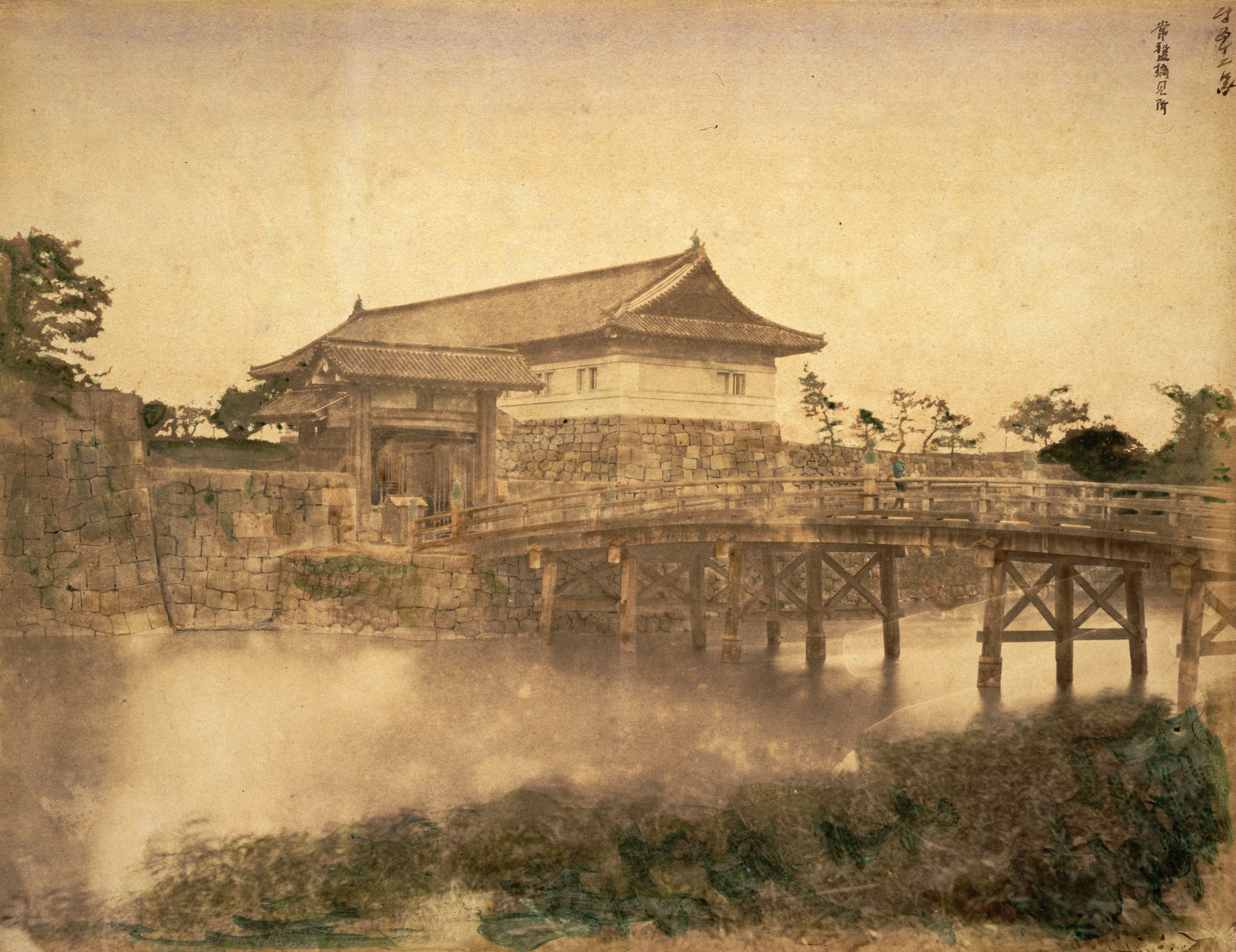
'Tokiwabashi-mon Bridge'
National Important Cultural property "Photograph Album of the Former Edo Castle"
Edo Castle, which is one of largest Japanese castles of the Early Modern period, had outer moats of about 14 kilometers from Kijibashi Bridge to Kandagawa River. Tokiwabashi-mon Gate had been the main gate of outer moats of Edo Castle.
This gate was built in Keicho Era, and the Masugata stone wall was constructed by feudal load of Ou (current Tohoku Region) in 1629. According to 'Edo-jo Gaikaku Gomon ezu (Illustrated Outer Gates of Edo Castle)',a wooden bridge which was Masugate-mon Gate with watariyagura-mon Gate and Korai-mon Gate had been before this Gate. From inside of the stone wall, wooden bridge pier which consist of a set of three wooden stakes, and abutment stone wall were found during the stone bridge repairing work.
In the Early Meiji Period, wooden bridges from castle gates begun to be replaced to stone bridges, as symbol of modernization of Tokyo. In 1877 Tokiwabashi Bridge was rebuilt to double arch stone bridge with stone of Koishikawa-mon Gate Stone Wall. This bridge has sidewalks and car lanes separated from each other, which was rare at that time. With marble newel post of bridge, granite surface and smart designed bridge handrail, it showed civilization and enlightenment. After its completion, it had been sights of Tokyo which was painted for Nishikie (colored woodblock print) or postcard.
The area around the Site of Tokiwabashi-mon Gate, together with modern cultural properties such as the Building of Bank of Japan, has been changed as the center of Edo Tokyo. Chiyoda City has overhauled this bridge damaged by the Great East Japan Earthquake of 2011, and carried out the restoration work to return its original state with various material."
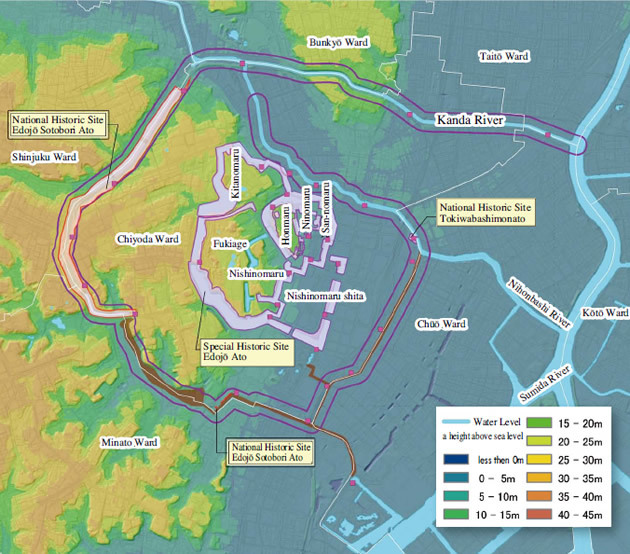
Topograpitical map of the former Edo Castle
Chiyoda city Course
The Permanent Exhibition of Hibiya Library & Museum
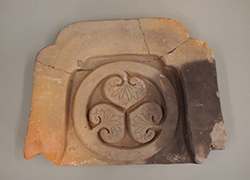
Mitsuba Aoi Onigawara excavated from Shiomi-tamon-yaguradai stone wall
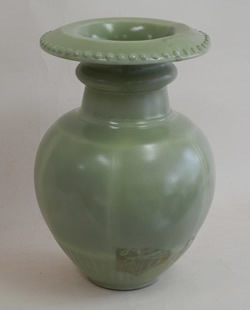
The vase excavated from
Shiomi-tamon-yaguradai stone wall
The Hibiya Library & Museum was located in Hibiya Park near the Imperial Palace and opened it as "a base of the intellect" concerning of the history and culture of Edo, Tokyo in 2011.
With all of the possession of the Yonbancho History Museum transferred to the new museum, we hold various exhibits and lectures, and promote policies for conservation of cultural properties in Chiyoda City.
In the main exhibition on the first floor, you can understand the history of Chiyoda City on a theme of "Establishment and Development of Edo, Tokyo". Of these, the exhibit of Edo Castle, titled "The Shogun's Castle Planning" , introduces the history of Chiyoda with the archaeological artifacts, pictures and the resource retrieval system with tablet computers.
Edo Castle construction process became clear by our excavations of the inside of Edo Castle, the outer moat of it and Site of Tokiwabashi-mon Gate carried out so far.
In our archaeological exhibit, you can see about the construction of the castle and the castle town planning by Shogun.
And you can see the state of Honmaru Goten from excavated Chinese ceramics considered that was kept in the castle, and a hollyhock marked ridge-end tile for Honmaru Goten which burned down by the Great Fire of Meireki (1657).
In addition, we introduce that the early stage of inside of the castle and that the samurai residence were lined in Marunouchi having the eaves were decorated with gold leaf from the reproduction of "'Edo scenes folding screens" (a possession of National Museum of Japanese History.)
Chiyoda City had been developed samurai residence and merchant place around Edo Castle, and as a center of the Japanese politics, culture and economy. And it has been developing as the center of capital city even after it became Tokyo.
Therefore a lot of cultural heritage from the early modern times to today still remain in Chiyoda City.
We intend to make a place for the people to learn our cultural heritage with "the walking map in Chiyoda", and provide an opportunity of the regional studies.
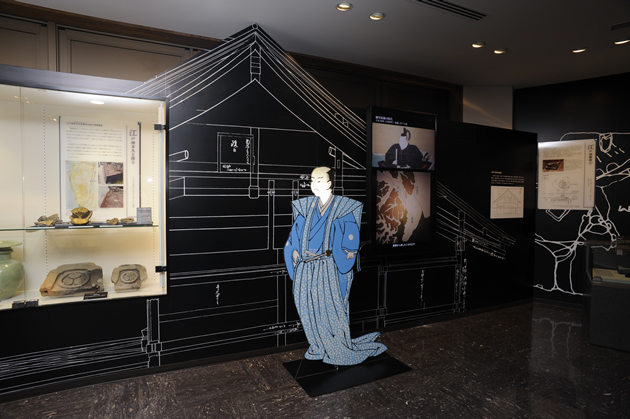
Permanent exhibitions at Hibiya Library & Museum
Chiyoda city Course
Walking through Edo Castle with the Illustrations by KORA Family
The Tokyo Metropolitan Central Library has stored a lot of materials related to the building of Edo Castle which passed down in the KORA Family who worked as Great Masters (a position of coordinating master carpenters) for generations. Among them, 646 pieces of "Materials related to the construction of Edo Castle" were designated as National Important Properties.
Sakuji-kata of the TOKUGAWA shogunate was a government office which took charge of the architectural department. As far as Edo Castle was concerned, the department was in charge of building Honmaru, Omote and Nakaoku of Nishinomaru, without Ooku. Therefore, this possession of Tokyo Metropolitan Central Library are mostly the illustrations of the center of Honmaru Goten, Omote and Nakaoku of Nishinomaru Goten where the retired shogun and the heir-apparent resided.
It is well known that fire broke out frequently in Edo. Edo Castle was repeatedly burned down and reconstructed over and over. The possession of the Tokyo Metropolitan Central Library is a series of architectural illustration at the time of reconstruction in 1860.
Among them, we would like to introduce three illustrations here, hoping these will be of some help you to get a clear image of Edo Castle.
1. Edo Onshiro no Ezu (Illustration of Edo Castle)
This is an overall illustration showing most of the entrenchments for Edo Castle except for Fukiage.
The areas of Honmaru, Ninomaru and San-nomaru seem to have been located in that of the current Imperial Palace. The current topography here has hardly changed from that of the Edo period. It is found with surprise that many place names and buildings still remain here and there to this day.
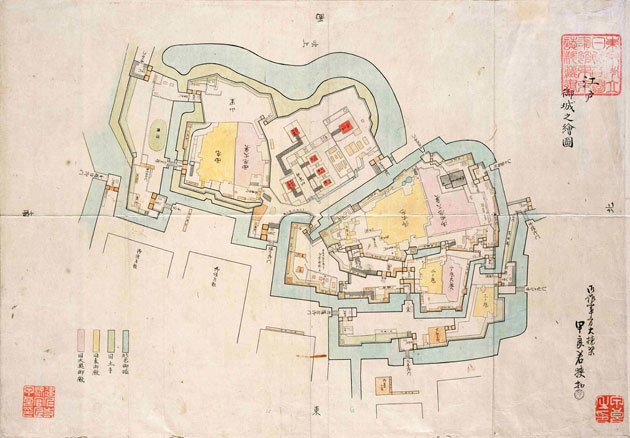
'Edo Oshiro no Ezu'
"Materials related to the construction of Edo Castle" Tokyo Metropolitan Central library
2. Edo-jo Gohonmaru On'omote On'nakaoku On'ooku Soezu
(Overall Illustration of the Inner Citadel, Front, Central and Inner Palaces of Edo Castle)
Honmaru Goten was a main building of Edo Castle, where the political affairs for the TOKUGAWA administration took place and the reigning shogun spent a daily life as well. An orange part of the illustration is Omote and Nakaoku area and a pink part is around the Ooku area. From the left to the right, in other words, from the south to the north, the total length was said to be about 500 meters. This illustration was a drawing depicting the whole Edo Castle which was rebuilt after the destruction by the Great Fire of Meireki in 1657. There was no Tenshu which had existed before the Great Fire, with only Tenshudai (donjon base) was included.
This Honmaru was also burned down in 1863 soon after the reconstruction of 1860, but the TOKUGAWA government was not financially secure enough to reconstruct it any longer, and used Nishinomaru as a replacement for the state of affairs until the end of TOKUGAWA administration.
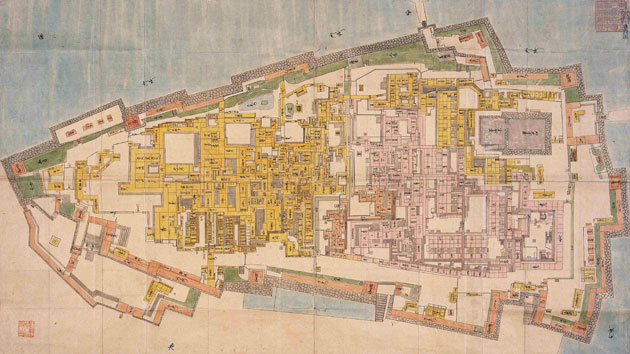
'Edo-jo Gohonmaru On'omote On'nakaoku On'ooku Soezu', Manji era
"Materials related to the construction of Edo Castle" Tokyo Metropolitan Central library
3. Edo-Onshiro Godenshu Shomen no Ezu
(Illustration of the Palace Facade of Donjon)
The period of when Tenshu (Donjon) of Edo Castle soared was only 51 years from 1607 originally built by TOKUGAWA Ieyasu until 1638 burned down by the Great Fire of Meireki. During the period, Tenshu was reconstructed twice by the second shogun TOKUGAWA Hidetada in 1623 and by the third shogun TOKUGAWA Iemitsu in 1638. It is said that this was an illustration of the 4th plans for reconstruction led by the Confucian scholar ARAI Hakuseki after the Great Fire of Meireki. The outside structure had five stories, while the inside structure had six stories including a cellar (basement), with the height of 44.8 meters to become the highest Tenshu in Japan at the time. Unfortunately, these reconstruction plans had never been realized before the TOKUGAWA administration came to the end.
∗ Note: All "the materials related to the construction of Edo Castle" are available in "TOKYO Archives" on the website of Tokyo Metropolitan Central Library.
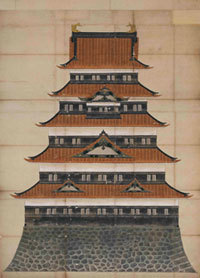
'Edo-Oshiro Gotenshu Shomen no Ezu', Shotoku era
"Materials related to the construction of Edo Castle"
Tokyo Metropolitan Central library
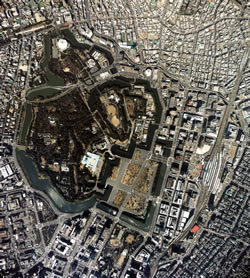
Edojo Ato (Data Provission : Chiyoda City Office of Education)
Tokyo Cultural Heritage Map
Would you like to go around cultural heritages? In Tokyo, there are various cultural heritages. This map helps you go around cultural heritages with efficiency during limited time in your trip. Japanese traditional temples and shrines, the cultural heritages concerned to most famous events and person in Japan and a lot of nature. This map introduces all of them widely! You must watch them and know the history and the culture of Tokyo!

SNS


















